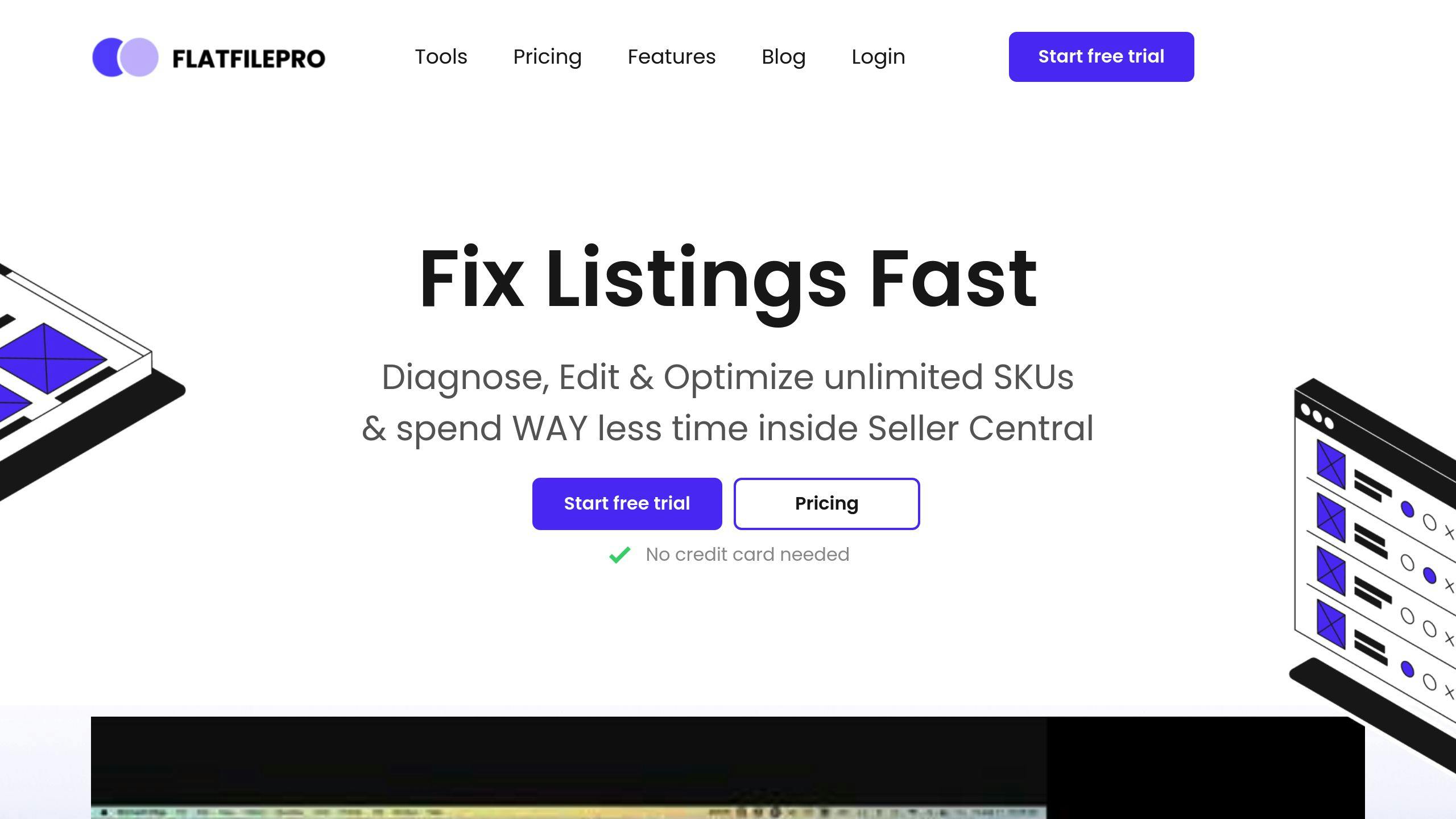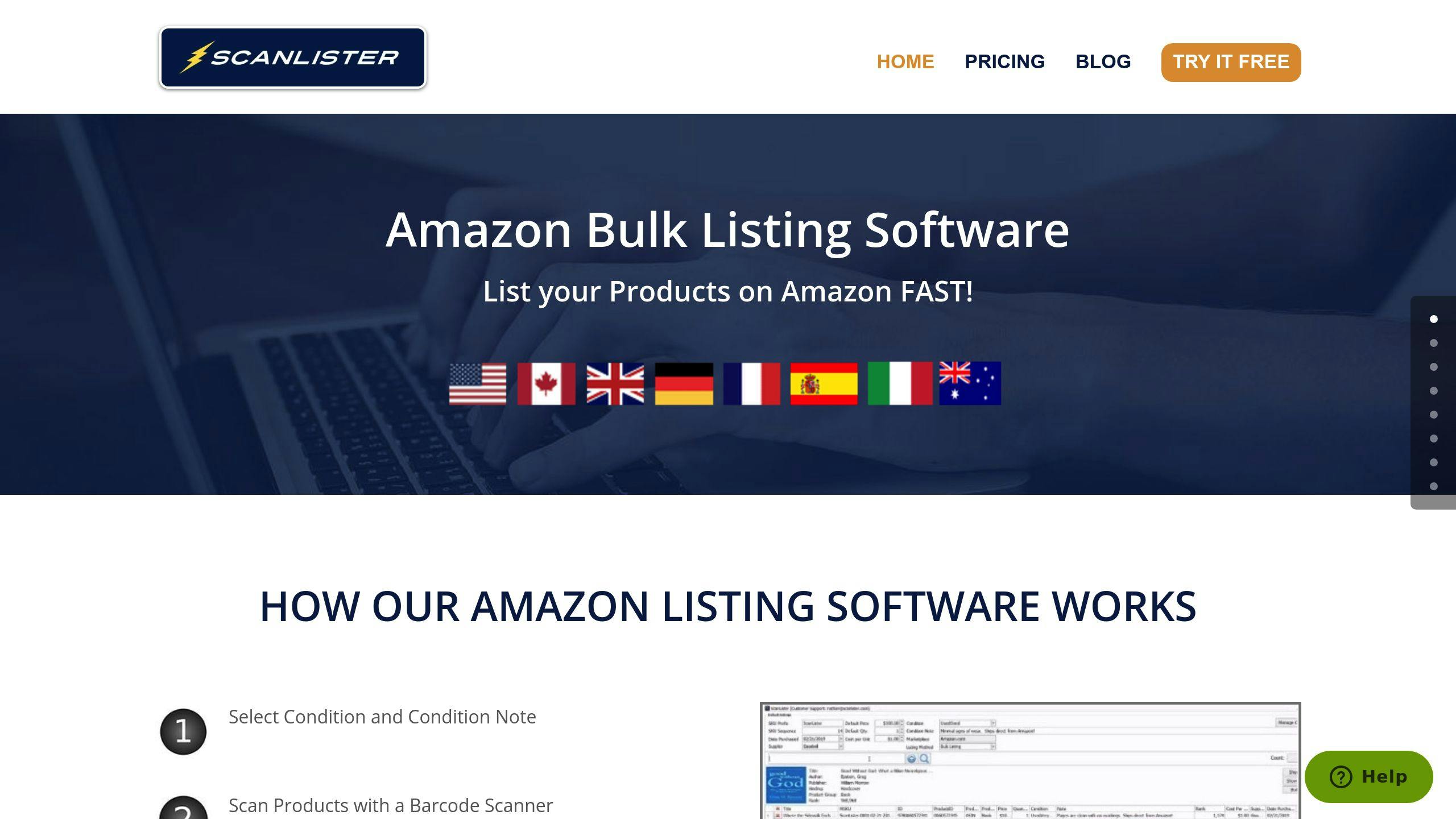Key Insights:
- Small Catalogs (<50 SKUs): Focus on manual management for detailed optimization. Prioritize high-quality product data (titles, images, keywords) and use basic tools like Seller Central or ScanLister for updates.
- Large Catalogs (>50 SKUs): Rely on automation and bulk editing tools like FlatFilePro to streamline operations. Centralized catalog management and AI-driven inventory forecasting are essential for efficiency.
Quick Comparison:
| Aspect | Small Catalogs | Large Catalogs |
|---|---|---|
| Management Approach | Manual focus on individual items | Automated bulk processing |
| Tool Requirements | Basic tools (e.g., ScanLister) | Advanced tools (e.g., FlatFilePro) |
| Time Investment | High per-item attention | Spread across catalog |
| Error Risk | Lower, easier to manage manually | Requires automated checks |
| Scalability | Limited | High with automation |
Takeaway:
For small catalogs, prioritize detailed listings and customer engagement. For large catalogs, invest in automation and centralized tools to ensure consistency and scalability. The right strategy depends on your catalog size and growth goals.
Automate Your Amazon Inventory and Manage Supplier Purchase Orders
Strategies for Small Catalogs
Managing a small catalog on Amazon offers the chance to focus deeply on each product, allowing sellers to fine-tune every detail for better performance. With fewer SKUs to handle, you can give each listing the attention it deserves.
Improving Product Data
When working with a small catalog, you can fine-tune product listings by focusing on descriptions, images, and keywords. Here’s a breakdown of key elements and their impact, based on Amazon Seller Central analytics:
| Element | Focus Area | Potential Impact |
|---|---|---|
| Product Titles | Clear, keyword-rich naming | 15-20% increase in click-through rates (according to Amazon Ads case studies) |
| Images | High-quality, multiple angles | 35% boost in conversions (based on marketplace data) |
| Bullet Points | Highlighting product benefits | 25% better engagement (from seller analytics) |
| Description | Easy-to-scan, detailed format | 40% fewer returns (industry benchmark) |
Simplifying Inventory and Fulfillment
With a smaller catalog, managing inventory becomes more straightforward. Using Amazon’s Fulfillment by Amazon (FBA) service, you can closely track sales trends, seasonal demand, and restocking needs. This helps you avoid overstocking and minimizes storage fees, all while setting the stage for future growth.
Combining Manual and Semi-Automated Tools
For catalogs with fewer than 50 SKUs, blending manual management with basic automation can save time while maintaining quality. Here are some tools to consider:
| Tool Type | Purpose | Time Required |
|---|---|---|
| Manual Seller Central | Basic listing updates | About 2-3 minutes per listing for updates |
| ScanLister | Updating prices and quantities | 30-60 seconds per update |
| SellerMobile | Tracking performance | 15 minutes daily (recommended minimum) |
With fewer products, focus on keeping listings accurate, keywords optimized, and customer service responsive. This attention to detail often results in better profitability per product compared to larger catalogs.
As we move into strategies for larger catalogs, the approach shifts toward automation and bulk management. Stay tuned for those insights.
Strategies for Large Catalogs
Handling large catalogs requires efficient systems and tools to manage hundreds or even thousands of SKUs without overwhelming your operations.
Using Bulk Editing Tools
Bulk editing tools are essential for managing extensive product catalogs efficiently. These tools simplify complex tasks, saving both time and effort.
| Tool Feature | Impact on Operations | Time Savings |
|---|---|---|
| Bulk SKU Updates | Edit hundreds of listings at once | Cuts editing time by 85% |
| Multi-Listing Management | Simplifies variations and syncs internationally | Speeds up adjustments by 80% |
| Version Control | Tracks and reverses catalog changes | Reduces listing errors by 60% |
These tools are great for streamlining updates, but pairing them with centralized catalog management ensures everything stays consistent across the board.
Centralizing Catalog Management
Centralized catalog management is a game-changer for large catalogs. It keeps everything organized and ensures your operations run smoothly.
Some key advantages include:
- Fewer Errors: Automated checks catch common mistakes before they happen.
- Brand Uniformity: Templates help standardize how your products look.
- Simplified Workflows: Integrated systems cut down on manual tasks like data entry.
- Better Teamwork: Teams can collaborate simultaneously without stepping on each other’s toes.
But catalog management doesn’t stop at listings – inventory control and demand forecasting are just as important for keeping your business profitable.
Managing Inventory and Forecasting
As your product range expands, staying on top of inventory levels and predicting demand is crucial. Advanced forecasting tools can take the guesswork out of stock management.
| Management Aspect | Tool Capability | Business Impact |
|---|---|---|
| Stock Level Tracking | Real-time inventory updates | Cuts stockouts by 40% |
| Demand Forecasting | AI-driven predictions | Boosts inventory turnover by 30% |
| Automated Reordering | Smart replenishment triggers | Lowers storage costs by 25% |
Platforms like SellerMobile offer analytics to help you spot areas for improvement. With its integration into Amazon’s Catalog API, SellerMobile automates updates and keeps your product data organized at scale [1][2][3].
sbb-itb-ed4fa17
Comparing Small and Large Catalogs
Pros and Cons Table
Here’s a quick look at how small and large catalogs differ in terms of scalability and operations:
| Aspect | Small Catalogs (<50 SKUs) | Large Catalogs (>50 SKUs) |
|---|---|---|
| Scalability | Limited by manual updates | Expands easily with automation |
| Time Management | Hands-on but time-consuming | Streamlined with bulk operations |
| Cost Structure | Lower tool costs, higher labor per item | Higher tool costs, lower labor per item |
| Quality Control | Easier to ensure consistency | Needs structured processes |
| Resource Requirements | Minimal technical skills required | Demands advanced tools and expertise |
| Update Speed | Slower, manual changes | Faster with bulk updates |
| Error Management | Simple to identify and fix manually | Relies on automated error detection |
Efficiency and Profitability
The size of your catalog plays a big role in how efficiently you can operate and how profitable you can be. Small catalogs let you focus on each product in detail, but they come with scalability challenges. On the other hand, large catalogs demand automation to stay efficient as you grow. In fact, sellers using automated tools for large catalogs often cut operational costs by 25%, all while maintaining listing quality [3].
Small Catalog Operations
Handling fewer than 50 SKUs gives you the chance to fine-tune every listing, often leading to higher conversion rates per product. However, manual processes can slow you down and drive up labor costs per item, making it harder to grow.
Large Catalog Operations
For larger catalogs, centralized systems and automation are game-changers:
- Boosts listing accuracy across multiple platforms
- Minimizes stockouts with automated tracking
- Improves inventory turnover using predictive analytics
By using these methods, sellers can scale up while keeping quality intact. To succeed, focus on centralized management, bulk updates, and tools that provide analytics and automate inventory processes.
The next section will dive into the tools designed to meet the needs of both small and large catalogs.
Catalog Management Tools
Having the right tools for catalog management can make a huge difference when growing your Amazon business. Different tools cater to different catalog sizes, so picking the right one is key.
FlatFilePro
FlatFilePro is built for handling large catalogs and tackling the challenges that come with them. Here’s what it offers:
- Unlimited SKU Management: Easily edit and manage an unlimited number of SKUs.
- Version Control: Keep track of listing changes with the Reflection Engine, ensuring a clear history of updates.
- International Marketplace Integration: Manage listings across multiple Amazon marketplaces from one dashboard.
| Plan | Monthly Cost | Best For | Key Features |
|---|---|---|---|
| Basic | $49 | Brand owners | Unlimited ASINs, change tracking |
| Log & Listings | $99 | In-house marketers | Bulk edits, variation management |
| Log, Listings & Data | $499 | Large brands & agencies | Advanced analytics with PostgreSQL database |
ScanLister
ScanLister is a simpler option, designed for sellers with smaller catalogs. It focuses on making basic tasks easy and error-free. If you’re managing fewer than 50 SKUs, this tool is a great fit. It helps you:
- Quickly update stock levels and pricing.
- Minimize errors, with users reporting up to 25% fewer inventory mistakes [2][3].
Its straightforward design makes it perfect for sellers who don’t need the complexity of enterprise-level tools.
Both FlatFilePro and ScanLister work seamlessly with Amazon Seller Central, giving you the flexibility to choose based on your catalog size and operational needs.
Conclusion
Small catalogs can benefit greatly from manual optimization and tools like ScanLister, which helps cut inventory errors by up to 25% [2][3]. For larger catalogs, bulk editing and centralized systems like FlatFilePro are essential for managing unlimited SKUs across multiple marketplaces [1].
The right catalog management tools can make a real impact. ScanLister is ideal for smaller operations, handling basic inventory tasks with ease. On the other hand, FlatFilePro provides advanced features tailored for large-scale, complex catalog management [2]. Additionally, analytics play a key role by pinpointing top-performing products, minimizing stockouts, and improving the turnover of slower-moving inventory [3].
Key elements to streamline your Amazon operations include:
- Tool Selection: Choose tools that align with your catalog size and operational needs.
- Accurate Data: Ensure product descriptions, keywords, and SKUs are precise to lower defect rates [4].
- Data Insights: Use analytics to fine-tune inventory levels and pricing strategies.
Whether you’re managing a small or large catalog, matching your strategy to your catalog size is crucial for growth and profitability. By evaluating your current needs and applying these strategies, you can take steps to boost your Amazon business efficiency right away.



